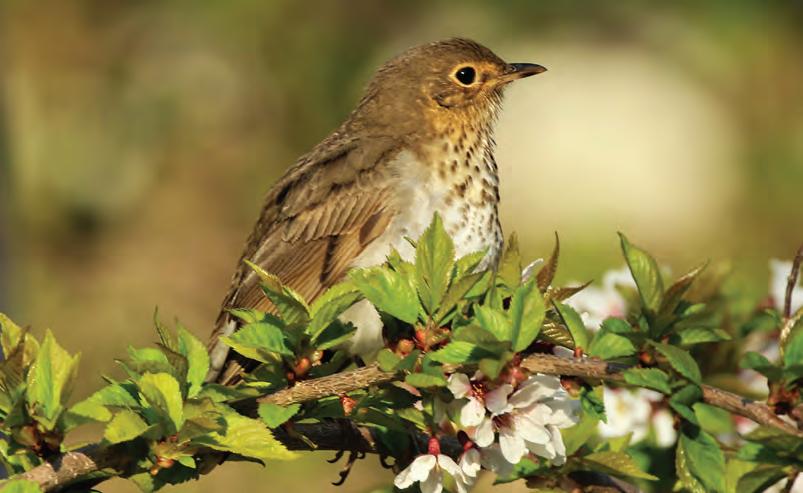
3 minute read
Design Your Garden to Attract Birds
You can attract birds to your garden with a little thoughtful planning. Birds need food, shelter and water and if you offer it to them, your habitat can attract a variety of different species.
Plants for Food
Depending on the species, birds eat seeds, berries, fruit, nectar and insects. Some like to forage at ground level, while others are found higher up in shrubs and trees. A birdfriendly landscape simulates the natural environment and is planted in layers with a variety of plants that grow to different heights. Consider planting the following for a bird friendly habitat:
Deciduous Trees
Fruiting plants are used by year-round residents and migratory birds preparing for winter. Some fruit (for example, crab apples) stays on the trees in winter to provide much needed sustenance when little else is available.
• Mulberries produce berries in July and August. They attract many species including indigo buntings, scarlet tanagers, mockingbirds and flycatchers.
• Dogwoods are covered with white, pink, or red flowers in spring with red fruit from August to November.
• Crab apples that remain on the trees in winter attract non migratory birds. Choose a small fruiting cultivar for birds to pick at easily.
• Serviceberries have masses of white or pinkish flowers in spring. The fruit appears in the summer and doesn’t last long before it is devoured, especially by American robins.
Conifers
• Spruce, fir and pine have seed-filled cones that appeal to nuthatches, finches, grosbeaks, chickadees and other seed-eating birds.
• Junipers and yews have berry-like cones that attract robins, cedar waxwings and sparrows.
• Yellow-bellied sapsuckers peck into conifers to get at the sugary sap that seeps out.
Shrubs and Vines
• Staghorn sumac has clusters of hairy red fruit that persist into winter and are eaten by many bird species.
• Viburnum species have white flowers in the spring. The berries that follow attract robins, bluebirds, thrushes, catbirds, cardinals, finches, waxwings and others.
• Wild grapes are a favourite of many birds.
• Virginia creeper produces small blueberries in the fall.
Annuals and Perennials
• Nectar-producing plants such as fuchsia, monarda, penstemon and salvia attract hummingbirds and orioles.
• Grasses, ornamental and native, provide seeds in fall.
• Oak, hickory, buckeyes, chestnuts and walnuts produce nuts and acorns that are eaten by birds in fall and winter.
For insect eaters
• Chickadees, woodpeckers, and nuthatches forage for insects and are attracted to dead and dying trees. Insects that tunnel under the bark become an important food source. A dead tree isn’t a bad thing in a garden! If you don’t have a dead tree in your yard, consider creating a brush pile in an out-of-the-way corner.
Give Them Shelter
Densely planted areas offer shelter and safety from harsh weather as well as predators (such as marauding cats and hawks). A cedar hedge is a safe haven for birds.
Provide Water
A water feature of any size is a magnet for birds. It should be shallow with sloping sides to make for easy access. Situating the birdbath in an open area allows birds to see potential danger lurking.
Resist the urge to be a neatnik
• A bird-friendly landscape isn’t perfectly manicured. Avoid clearing away seed heads and spent foliage in the fall. In winter when little else is available, the birds will appreciate the dining opportunities.
• A dead tree attracts woodpeckers or nuthatches who make their nests in cavities. Many species seek shelter from bad weather inside these hollowed out trees.
Reduce or eliminate your Lawn
Lawns have little value to birds or other wildlife, and they require more energy for mowing, applying fertilizers and watering.

